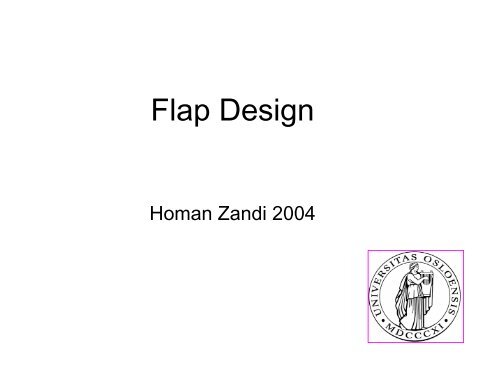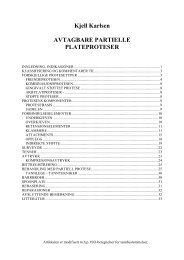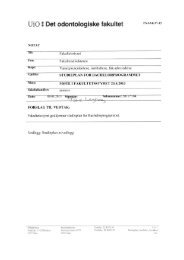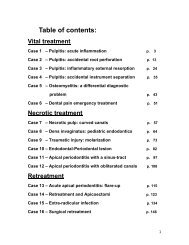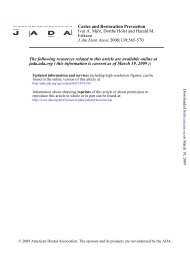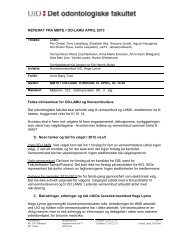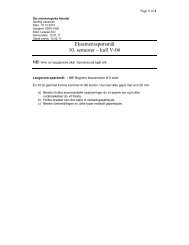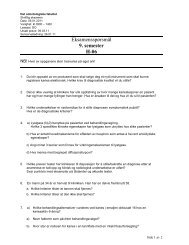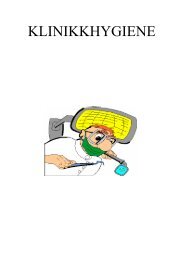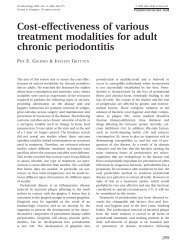Flap Design
Flap Design
Flap Design
Create successful ePaper yourself
Turn your PDF publications into a flip-book with our unique Google optimized e-Paper software.
<strong>Flap</strong> <strong>Design</strong><br />
Homan Zandi 2004
Enamel<br />
Attached Gingiva<br />
Free Gingiva<br />
JE<br />
CEJ<br />
Connective Tissue<br />
Alveolar Mucosa<br />
Mucogingival Junction<br />
Homan Zandi
Objective<br />
• The flap should offer adequate access and<br />
have an adequate blood supply<br />
• The flap must be of adequate size and<br />
fully reflected<br />
• The edges must lie on the sound bone
Mucoperiosteal <strong>Flap</strong><br />
• Mucosa<br />
• Connective tissue<br />
• Periosteum<br />
Homan Zandi
Considerations<br />
• The number of teeth involved in the surgery<br />
• The length and shape of the roots involved<br />
• The dimensions of the lesion<br />
• The amount of attached gingiva<br />
• The existence and depth of periodontal<br />
pockets<br />
• The locations of muscle attachments and<br />
frenums<br />
• The height or depth of the vestibule<br />
• The location of anatomic structures, such as<br />
the neurovascular bundles and the maxillary
Techniques<br />
• Gingival flap<br />
• Intrasulcular flap (marginal)<br />
– Triangular<br />
– Rectangular<br />
• Semilunar flap<br />
• Submarginal flap<br />
– Ochsentein-Luebke flap
Homan Zandi
Gingival <strong>Flap</strong><br />
• Indications<br />
– Cervical resorptive<br />
defects<br />
– Cervical area<br />
perforations<br />
– Periodontal<br />
procedures<br />
Homan Zandi
Intrasulcular <strong>Flap</strong><br />
• Indications<br />
(Triangular)<br />
– Periapical Sugery<br />
Postrerior areas<br />
Homan Zandi
Intrasulcular <strong>Flap</strong><br />
• Indications<br />
(Rectangular)<br />
– Multiple teeth<br />
– Large lesions<br />
– Long roots<br />
Homan Zandi
Semilunar <strong>Flap</strong><br />
• Indications<br />
– Esthetic crowns<br />
Homan Zandi
Submarginal <strong>Flap</strong><br />
Ochsenbein-Luebke <strong>Flap</strong><br />
• Indications<br />
– Prosthetic crowns<br />
Homan Zandi
Incision<br />
• Tissue should be handled gently<br />
• Sharp dissection should be used<br />
• Careful hemostasis should be attained<br />
• Tension should be avoided
# 11 Scalpel # 15C Scalpel<br />
Homan Zandi
# 12 Scalpel<br />
Homan Zandi
Most endodontic surgery problems can<br />
be avoided by using the following<br />
incision rules<br />
1. Firm continuous incision
2) An incision should not cross an underlying bony<br />
defect<br />
Homan Zandi
2) An incision should not cross an underlying bony<br />
defect<br />
Homan Zandi
2) An incision should not cross an underlying bony<br />
defect<br />
Homan Zandi
2) An incision should not cross an underlying bony<br />
defect<br />
Homan Zandi
3) The vertical incision should be in the concavities<br />
between bone eminences<br />
Homan Zandi
Homan Zandi
4) The vertical incision should not extend into the<br />
muccobuccal fold<br />
Homan Zandi
4) The vertical incision should not extend into the<br />
muccobuccal fold<br />
Homan Zandi
5) The termination of the vertical incision at the gingival<br />
crest must be at the mesial or distal line angle of the<br />
tooth<br />
Homan Zandi
6) The base of the flap must be at least equal to the width<br />
of its free end<br />
Homan Zandi
Homan Zandi
Homan Zandi
Homan Zandi
Homan Zandi
Most endodontic surgery problems can be<br />
avoided by using the following incision rules<br />
1) Firm continuous incision<br />
2) An incision should not cross an underlying bony<br />
defect<br />
3) The vertical incision should be in the concavities<br />
between bone eminences<br />
4) The vertical incision should not extend into the<br />
muccobuccal fold<br />
5) The termination of the vertical incision at the<br />
gingival crest must be at the mesial or distal line<br />
angle of the tooth<br />
6) The base of the flap must be at least equal to the<br />
width of its free end


